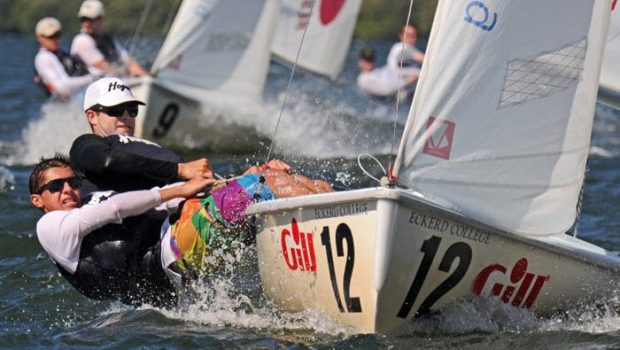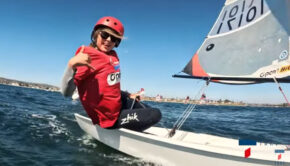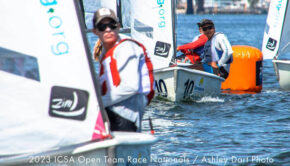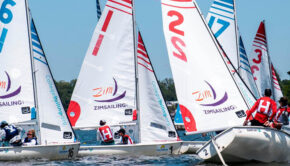Feeling the Pinch of Progress
Published on September 24th, 2018
by Craig Leweck, Scuttlebutt
There are very few areas of our lives not capable of being impacted by the concerted efforts of people that seek to try harder. We are surrounded by competition, and when dissected, it is quite possible to determine how to compete better. But nothing comes without cost, a reality impacting our sport as a result of the road to, and through, college sailing.
We are in a generation of excellence, and sailing is not alone in being impacted. Every example of competition, whether it be academic or athletic, can see an increasing cost. It simply comes down to who can make the payment. Success comes to those who are willing to try harder, invest more, and make greater sacrifices to achieve their goal.
I think back to my days of college sailing in the early 80s in California. How people prepared before their freshman year was as varied as the sport itself. Once past the Sabot years, young people got involved in whatever was active in their harbors. There was very little peer-based sailing, with most teenagers getting schooled by competing with and against adults. Heck, we may even have sailed in jeans.
We all raced like bandits as teenagers, most of us active in dinghy one designs like Lasers, Lido 14s, and Snipes. When it came time for college, few traveled far, so the talent fed into the west coast colleges.
Between 1967 and 1990, Southern California teams won nearly half of the spring coed dinghy nationals. Only a couple teams had legitimate school support while the others were randomly run by students. But sailing is sailing, and when everything else is equal, good sailors excel.
Since we hadn’t wandered far for our schooling, and as we had already been vested in adult segments of the sport, when college was over, we just kept doing what we had been doing. There was no lag on what to do next, but those days are so over.
West coast talent soon began drifting from these meager local programs to the increasingly funded schools on the east coast. This talent drain shuttered some of the California college programs, and overall it lowered the skill level of conference competition. Only Stanford can compete nationally, but that’s due to regularly hopping planes east. For those kids, they graduate with an epic education and a bounty of frequent flyer miles.
The competitive imbalance in college sailing is now significant. There may be seven Inter-Collegiate Sailing Association (ICSA) conferences, but only three – New England, Mid Atlantic, and South Atlantic – can consistently compete for the spring coed nationals. In fact, the imbalance is so significant that the ICSA changed their championship structure to insure the best schools were competing for the titles.
Whereas in the past, each conference was entitled to have their top schools compete in the coed finals, now they are only invited to the championship qualifier, called the Semi Finals. They lengthened the regatta to have an elimination series, with the top half advancing to the finals. In 2018, schools from the Midwest, Northwest, and South didn’t make the cut.
While the format makes sense, creating the best competition for the highest honor, it puts a strain on the underfunded programs. When scrapping for support to travel to nationals, and if qualifying for all three titles – Women’s, Team Racing, and Coed – it is now nearly a two week commitment.
While the bigger programs may be shuttling sailors in for the different events, the smaller programs are stretching their roster to attend, just so they can likely get eliminated before the party really starts. Thanks for coming…
Just like all other areas of our sport, college sailing is impacted by escalating competition. Rules are in place in hopes of holding down the ceiling, limiting the amount of time a student can participate in athletically related activities.
But schools are operating on the honor system, with no impactful oversight to catch offenders. Rules also state no scholarships can be provided, yet it is rumored how savvy coaches direct school grants toward top sailors. Ironically, these rules also hurt a weak sailing program from raising its game.
With an active racing calendar in both the fall and spring, ICSA acknowledges their schedule is impacting a student’s ability to expand their school involvement.
I recall when my son had plans to play baseball in college, but the more my wife and I learned about the opportunities presented by the school, and how he would be kept from them, we wondered whether his plan was the right path. He wondered too, deciding in his freshman year to focus solely on academic life.
Not every sport fits cleanly into a fall or spring semester, and with ICSA organizing a total of five national titles, along with a list of iconic events and necessary conference qualifiers, fitting it all into one season would require cuts. But when you consider how events in the spring are impacted by winter freeze, notable in the Midwest when they often can’t sail until nationals, a fall-only season makes sense.
A fall-only season would also solve a growing conflict between college sailing and Olympic sailing. The days are gone when a top college sailor can expect to succeed at the next level by beginning their campaign after graduation. Their training must occur during those school years, which means balancing academics along with two intensive sporting pursuits. Hard to do well in all three areas.
While not to minimize the importance of an education, there are plenty of examples of immensely successful people without degrees. Steve Jobs, Richard Branson, Larry Ellison, and Michael Dell didn’t graduate from college. Elite athletes in other sports can go to college to prepare for the next level, because their sport’s rules and format remain consistent. But not so in sailing.
John Kostecki, the youngest at 48 years to ever be inducted in the National Sailing Hall of Fame, made only a dent on a college degree before Olympic and professional sailing pursuits became his priority. Just saying…
While ICSA is not yet ready to take the step toward being a one season sport, they have reduced the number of competition weekends to 20 (excluding nationals), with plans to reduce further to 18 weekends in 2018-19.
It is impressive the type of schools contending at the top level of college sailing. The Ivy League is well represented, along with military academies and elite private schools along the Atlantic. Given the prestige of graduating from a notable institution, the road toward college is impacted. Teens and parents recognize that performance in youth doublehanded boats raises their stock in the eyes of college coaches.
This means more training and attending all the prominent national events. Deviating from this game plan is discouraged. Concern about the nuttiness of parents to improve their skipper’s results warranted the Club 420 Class to issue a memo against hiring (and paying) elite crew.
Then there is the explosive growth of the Interscholastic Sailing Association (ISSA) for high school students, which mirrors the college format, thus improving the view of the rising crop.
This is about building a resume, and as college admissions tend to give coaches a number of ‘easy entrance’ passes, sailing performance can make up for academic shortcomings. And if a parent is lucky enough to have a highly sought after prospect, the blurry road toward financial grants exists.
It is notable the disruption this is having elsewhere in our sport. Young people had previously filled that nimble keelboat foredeck position or were the hard hiking dinghy crew, with many then transitioning to ownership in small boats. But that flow of young crew has been derailed by the youth agenda. In my era, we all rolled into the dinghies we already owned after our school years. Today, not so much.
The mission statement of my club’s junior program is “to develop knowledgeable youth sailors and to instill in them a love for the sport of sailing that will serve as a foundation for the future of the Club.” Translated, the investment the club makes is a long-term gamble to make new members.
That had previously been a good bet when young people didn’t drift too far for their studies. But now they do, and with better job placement tending to exist in each school’s immediate region, the odds are longer that kids return to their home club. And if they do, their lack of connection with local fleets makes for a rocky return.
My two boys didn’t last long in the junior program, which my wife and I viewed as a mixed blessing. We wanted them to embrace sailing as we had, though in hindsight we failed to present to them the full range the sport has to offers. But if they continued to climb the competitive youth pyramid, we knew that would have been a financial strain too.
All youth sports are feeling this pinch, and it takes some wisdom to see through the trees. What is the goal, to make champions or life sailors? The paths are not necessarily the same, and very few kids from that beginner class will compete collegiately. The best sailors will always elevate, so programs need to focus on how best to introduce the love and variety of sailing, not just the path to college.









 We’ll keep your information safe.
We’ll keep your information safe.